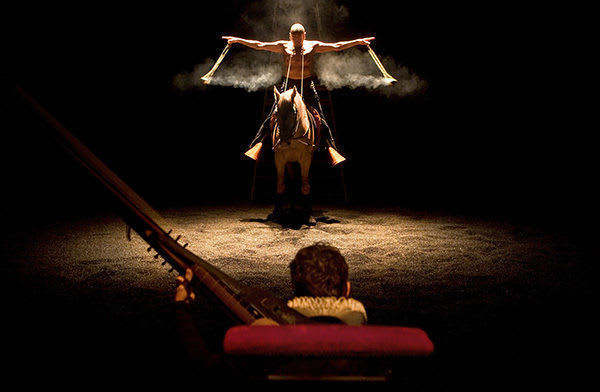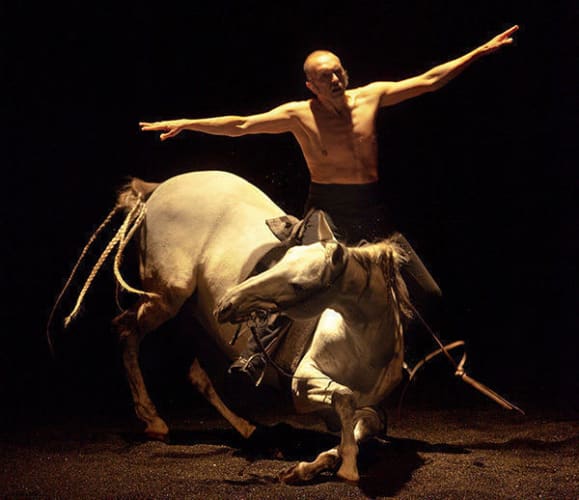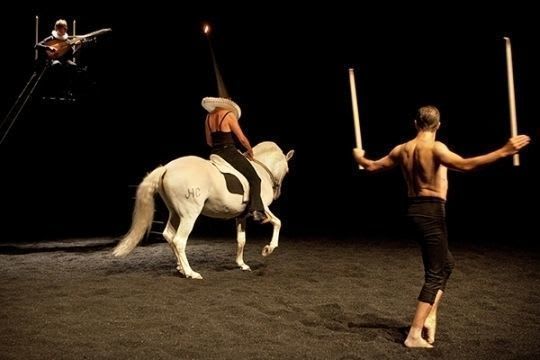Bartabas has never performed any of his Théâtre Equestre Zingaro company’s large-scale productions in the UK. This, like The Centaur and the Animal, which he brought to the Wells in 2011, is a work using smaller resources designed for theatres but there is nothing small scale about its impact.
The previous piece was a collaboration between Bartabas and his horses and a Butoh performer. This time their performing partner is flamenco star Andrés Marín with music provided by countertenor Christopher Baska, lutanist Marc Wolff and Adrien Mabire on cornet and support from diminutive actor William Panza.
Golgota is a blending of elegant equestrian theatre and dressage, flamenco and contemporary dance, divine music and skillful staging, topped and tailed with a delightful comic touch provided by Panza.
It doesn’t offer a clear-cut scenario. Bartabas likes his shows to present the audience with a puzzle. Interviewed by Stephen Moss for The Guardian, he quoted Proust saying, “it’s the reader not the writer who makes a book”. Each person in the audience makes their own story.
Bartabas says he doesn’t believe in God but Golgota (Golgotha) was the place of Christ’s crucifixion and its progress strongly echoes religious ritual. The music of sixteenth-century Spanish renaissance priest-composer Tomás Luis de Victoria (especially his motets for solo voice) is the current on which the whole work flows.
The Seville Semana Santa is an obvious influence. Here are the tall conical hats of its penitents, its burning tapers, its re-enactment of the Passion; Marín uses a horse’s tail for self flagellation, he kneels before a horse as though making confession, another horse has its face masked. There is a donkey, Christ’s mount for Palm Sunday, ritual foot washing as on Maundy Thursday and a repeated image of a white horse and its rider slipping sideways to the ground recalls collapses on the way to Calvary and the depositions and pietás of religious painting. Swinging censers patterning the air with their smoke, the tintinnabulation of bells, formal procession and ritual changes of garment make this feel like a mass.
There are ruffs making figures look as though they come from an El Greco painting, Panza could be a Spanish court dwarf from a Velasquez and the changing chiaroscuro that allows horses to appear like ghosts out of the darkness recalls Zurbarán (the lighting by Laurent Matignon). The costumes by Sophie Manach and Yannick Laisné feature shirts that turn into head shrouds, skirts that become draperies, a sudden splash of red against the general formal black with white ruff highlights, flesh catching light.
These potent images are part of a choreography in which men and horses reciprocate. Sometimes they seem to be in conversation, sometimes Marín leads, sometimes it is a horse whom he responds to. In one compelling sequence of dancing dressage, Marin’s feet mirror the horse’s hooves step by precise step.
Bartabas always seems at one with the horse he is riding, not giving instructions but thinking together, his movements in the saddle hieratical. Marín is mainly bare-footed and on a stage covered in rubber crumbs (to be more like the earth the horses) his footwork is soundless, the rhythms now become visual in sharp articulation and sudden flicks. He is a graceful performer who packs every move with emotion. Later, in shoes, he beats out solo zapateado on a chair seat, or uses metal finger stalls to strike complex rhythms on a sheet of metal held before him before dancing upon it.
The horses are all elegant dancers and they turn dressage into poetry. Horizonte, Le Tintoret, Soutine and Champagne are wonderfully controlled in slow gyrations, delicate prancing, moving silently spectre like or cantering round the stage, their ears twitching with intelligence. Not so much is expected of Lautrec the donkey but they are all wonderful to watch.
The audience is requested not to clap until the end, lest it disturb the horses, and this also ensures no break in the way this beautifully shaped piece holds the attention. It is full of religious references but it is not about worship. At its heart, its rituals seem much more about the relationship between its participants and a response to Victoria’s music.


